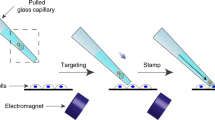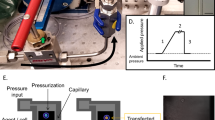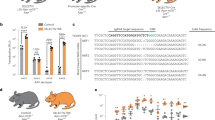Abstract
We describe a mechanical method for delivery of adenoviral vector to the adventitial surface of arteries and to other tissues. Our goal was to characterize, principally in intact carotid artery, the morphological, biochemical, and functional effects of mechanical delivery of a recombinant β-galactosidase-expressing adenoviral vector following its direct application using a small paintbrush. Our ex vivo and in vivo data demonstrate efficient, accurate, and rapid transduction of arteries without compromise of their morphological, biochemical, and functional integrity. We also demonstrate the general applicability of this technique in vivo via transduction of skeletal muscle, fibrotendinous tissue, peritoneum, serosal surface of bowel, and wounded skin. We conclude that direct mechanical delivery of an adenoviral vector to tissues using a suitable paintbrush represents an intuitive, accurate, and effective means of augmenting gene transfer efficiency, and may be a useful adjunct to other delivery methods.
This is a preview of subscription content, access via your institution
Access options
Subscribe to this journal
Receive 12 print issues and online access
$259.00 per year
only $21.58 per issue
Buy this article
- Purchase on Springer Link
- Instant access to full article PDF
Prices may be subject to local taxes which are calculated during checkout





Similar content being viewed by others
References
Davidson BL et al. A model system for in vivo gene transfer into the central nervous system using an adenoviral vector. Nat Genet 1993; 3: 219–223.
Ooboshi H et al. Adenovirus-mediated gene transfer in vivo to cerebral blood vessels and perivascular tissue. Circ Res 1995; 77: 7–13.
Chen AFY et al. Expression and function of recombinant endothelial nitric oxide synthase gene in canine basilar artery. Circ Res 1997; 80: 327–335.
Chen AFY et al. Effects of in vivo adventitial expression of recombinant endothelial nitric oxide synthase gene in cerebral arteries. Proc Natl Acad Sci USA 1997; 94: 12568–12573.
Cable DG et al. New approaches to prevention and treatment of radial artery graft vasospasm. Circulation 1998; 98: II15–II22.
Christenson SD et al. Adenovirus-mediated gene transfer in vivo to cerebral blood vessels and perivascular tissue in mice. Stroke 1998; 29: 1411–1416.
Isner JM et al. Treatment of thromboangiitis obliterans (Buerger's disease) by intramuscular gene transfer of vascular endothelial growth factor: preliminary clinical results. J Vasc Surg 1998; 28: 964–973.
Laitinen M et al. Adenovirus-mediated gene transfer to lower limb artery of patients with chronic critical leg ischemia. Hum Gene Ther 1998; 9: 1481–1486.
Rekhter MD et al. Gene transfer into normal and atherosclerotic human blood vessels. Circ Res 1998; 82: 1243–1252.
Schneider DB et al. Adventitial delivery minimizes the proinflammatory effects of adenoviral vectors. J Vasc Surg 1999; 29: 543–550.
Khurana VG et al. Adenovirus-mediated gene transfer to human cerebral arteries. J Cereb Blood Flow Metab 2000; 20: 1360–1371.
Toyoda K et al. Gene transfer of calcitonin gene-related peptide to cerebral arteries. Am J Physiol 2000; 278H: 586–H594.
Khurana VG et al. Protective vasomotor effects of in vivo recombinant endothelial nitric oxide synthase gene expression in a canine model of cerebral vasospasm. Stroke 2002; 33: 782–789.
Heistad DD, Faraci FM . Gene therapy for cerebral vascular disease. Stroke 1996; 27: 1688–1693.
Russell SJ . Science, medicine, and the future: gene therapy. Br Med J 1997; 315: 1289–1292.
Chen AFY, O'Brien T, Katusic ZS . Transfer and expression of recombinant nitric oxide synthase genes in the cardiovascular system. Trends Pharmacol Sci 1998; 19: 276–286.
O'Brien T, Simari RD . Gene therapy for atherosclerotic cardiovascular disease: a time for optimism and caution. Mayo Clin Proc 2000; 75: 831–834.
Khurana VG, Katusic ZS . Gene transfer for cerebrovascular disease. Curr Cardiol Rep 2001; 3: 10–16.
Kullo IJ et al. Adventitial gene transfer of recombinant endothelial nitric oxide synthase to rabbit carotid arteries alters vascular reactivity. Circulation 1997; 96: 2254–2261.
Kullo IJ et al. Enhanced endothelium-dependent relaxations after gene transfer of recombinant endothelial nitric oxide synthase to rabbit carotid arteries. Hypertension 1997; 30: 314–320.
Palasis M, Luo Z, Barry JJ, Walsh K . Analysis of adenoviral transport mechanisms in the vessel wall and optimization of gene transfer using local delivery catheters. Hum Gene Ther 2000; 11: 237–246.
Tsutsui M et al. Adventitial expression of recombinant eNOS gene restores NO production in arteries without endothelium. Arterioscler Thromb Vasc Biol 1998; 18: 1231–1241.
Toyoda K et al. Calcium phosphate precipitates augment adenovirus-mediated gene transfer to blood vessels in vitro and in vivo. Gene Ther 2000; 7: 1284–1291.
March KL, Madison JE, Trapnell BC . Pharmacokinetics of adenoviral vector-mediated gene delivery to vascular smooth muscle cells: modulation by poloxamer 407 and implications for cardiovascular gene therapy. Hum Gene Ther 1995; 6: 41–53.
Morling FJ, Russell SJ . Enhanced transduction efficiency of retroviral vectors coprecipitated with calcium phosphate. Gene Ther 1995; 2: 504–508.
Kim S et al. Transcriptional targeting of replication-defective adenovirus transgene expression to smooth muscle cells in vivo. J Clin Invest 1997; 100: 1006–1014.
Qui C, De Young MB, Finn A, Dichek DA . Cationic liposomes enhance adenovirus entry via a pathway independent of the fiber receptor and αv-integrins. Hum Gene Ther 1998; 9, 507–520.
Kalyanasundaram S et al. Coacervate microspheres as carriers of recombinant adenoviruses. Cancer Gene Ther 1999; 6: 107–112.
Williams RS et al. Introduction of foreign genes into tissues of living mice by DNA-coated microprojectiles. Proc Natl Acad Sci USA 1991; 88: 2726–2730.
Lund DD et al. Adenovirus-mediated gene transfer is augmented in basilar and carotid arteries of heritable hyperlipidemic rabbits. Stroke 1998; 29: 120–125.
Onoue H et al. Expression and function of recombinant endothelial nitric oxide synthase gene in canine basilar artery after experimental subarachnoid hemorrhage. Stroke 1998; 29: 1959–1966.
Muhonen MG et al. Gene transfer to cerebral blood vessels after subarachnoid hemorrhage. Stroke 1997; 28: 822–829.
Dunn CJ, Goa KL . Fibrin sealant: a review of its use in surgery and endoscopy. Drugs 1999; 58: 863–886.
Yu WH et al. Topical gene delivery to murine skin. J Invest Dermatol 1999; 112: 370–375.
Acknowledgements
We thank Mr John V Hagen (Mayo Medical Illustrations) and the staff of Carson Art Supply (Rochester, MN, USA) for their invaluable advice regarding paintbrush classification and selection. We also gratefully acknowledge the assistance of Ms Janet Beckman and Ms Maureen Craft with preparation of this manuscript. This work was supported in part by National Heart, Lung and Blood Institute Grant HL-53524, National Institute for Neurological Disorders and Stroke Grant NS-37491, the American Heart Association-Bugher Foundation Award for the Investigation of Stroke (ZSK), and funds from the Thoralf Sundt Fellowship in Neurosurgical Research (VGK) and the Bruce and Ruth Rappaport Program in Vascular Biology (ZSK, TO, RDS), Mayo Clinic and Mayo Foundation.
Author information
Authors and Affiliations
Rights and permissions
About this article
Cite this article
Khurana, V., Weiler, D., Witt, T. et al. A direct mechanical method for accurate and efficient adenoviral vector delivery to tissues. Gene Ther 10, 443–452 (2003). https://doi.org/10.1038/sj.gt.3301907
Received:
Accepted:
Published:
Issue Date:
DOI: https://doi.org/10.1038/sj.gt.3301907



